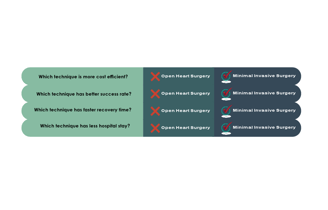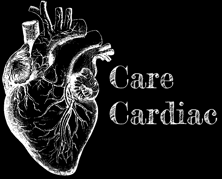
Is Minimal Invasive technique a good replacement of Open Heart Bypass Surgery?
Traditional Open-Heart Surgery
Minimally Invasive Cardiovascular Surgery
Traditional open-heart surgery is a time-tested and trusted approach for addressing a range of complex heart conditions. In this procedure, the surgeon creates a sizable incision in the chest, providing direct access to the heart. During the surgery, the patient is connected to a heart-lung machine, temporarily assuming the essential functions of the heart and lungs. This allows the surgeon to work on the heart without it beating, enabling intricate procedures such as coronary artery bypass grafting (CABG), heart valve repair or replacement, and the repair of complex congenital heart defects. With a rich history of success, traditional open-heart surgery remains a reliable and effective option for specific cases in cardiac care.
Minimally invasive heart surgery is an advanced approach to cardiac procedures, utilizing smaller incisions, often placed between the ribs, in contrast to the larger chest incision required in traditional open-heart surgery. This method often obviates the need for a heart-lung machine, offering a less invasive alternative. Minimally invasive surgery is versatile, catering to various cardiac procedures, including minimally invasive coronary artery bypass grafting (MICS-CABG) and valve surgery. The advantages of this approach are numerous, encompassing reduced scarring, diminished postoperative discomfort, shorter hospital stays, and a swifter recovery. As a result, it's gaining popularity as an appealing choice for a growing range of heart surgeries.
Determining the suitability of minimally invasive heart surgery for a patient hinges on several crucial factors, encompassing their unique heart condition, medical history, and individual anatomy. It's important to note that not all patients are ideal candidates for minimally invasive procedures. The decision-making process typically entails a comprehensive assessment conducted by a highly skilled cardiac surgeon. Key considerations during this evaluation include the intricacy of the necessary procedure, the patient's overall health, and the surgeon's proficiency in minimally invasive techniques. Throughout this evaluation, the surgeon will engage in a candid discussion with the patient, shedding light on both the advantages and potential risks associated with the minimally invasive approach. This section serves as an invaluable resource for patients, offering insight into what to anticipate during the consultation and evaluation process, thus empowering them to make an informed and confident decision regarding the most suitable treatment for their unique heart condition.
Is Minimally Invasive Cardiovascular Surgery Right for You?


Questions we are focusing on?
Who is the best Heart Surgeon in India?
Is Minimal Invasive technique a good replacement of Open Heart Bypass Surgery?
At Care Cardiac, we are guided by a team of independent researchers who are passionate about one thing - your heart health. We understand that when it comes to selecting the top cardiac surgeons in India, your research shall stand next to none.
Determining the suitability of minimally invasive heart surgery for a patient hinges on several crucial factors, encompassing their unique heart condition, medical history, and individual anatomy. It's important to note that not all patients are ideal candidates for minimally invasive procedures.
Is Open Heart Coronary Artery Bypass Graft (CABG) surgery safe?
Coronary Artery Bypass Graft (CABG) surgery is a common and well-established procedure used to treat coronary artery disease, a condition in which the blood vessels supplying the heart (coronary arteries) become narrowed or blocked, often due to the buildup of fatty deposits (atherosclerosis).
How long does it take to recover from heart surgery?
The recovery period following heart surgery, such as Coronary Artery Bypass Graft (CABG) surgery or heart valve surgery, can vary depending on several factors, including the type of surgery, the patient's overall health, and the presence of any complications.
